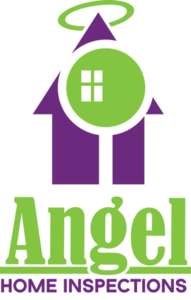Drones Used During Home Inspections
By Inspector Bill
Using Aerial Drones During Home Inspections is Growing Rapidly
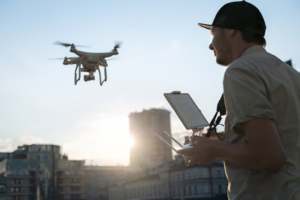
Many home inspectors are now incorporating the use of aerial drones during inspections. Modern flying drones are definitely useful and can be an important aid for accessing previously inaccessible areas—for instance steep pitched roofs, wet roofs, and surrounding land contours. As the use of drones has escalated, the legal and ethical limitations are constantly evolving. This is another case of modern technology developing faster than laws and regulations. However, there are some clear-cut regulations already in place. These include who is permitted to operate drones commercially, the registration of drones, and drone flight restrictions. Failure to comply with the laws and regulations could potentially expose the inspector, the realtor, and the home owner to legal liability. Some of the potential civil penalties for drone violations include fines up to $27,500 and/or criminal penalties. Also, there is always the risk of personal injury or property damage from the use of a drone. Accordingly, before using a drone during an inspection or hiring an inspector who uses drones, please do your due diligence first.
Here is a brief outline of the applicable laws, rules, and regulations applicable to drone use.
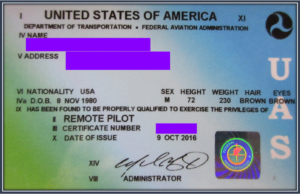
FAA remote pilot certificate with personal information removed
Remote Pilot’s License–Probably the most important requirement is complying with the Federal Aviation Administration (FAA) requirements applicable to small Unmanned Aircraft Systems (FAA legalese for “drone”). The FAA requires all commercial drone pilots to hold a Part 107 certificate or “remote pilot certificate.”—basically a drone pilot license. The FAA makes it clear that the “pilot-in-charge” of any commercial aerial drone operation must hold the Part 107 Certificate. The FAA also further requires the pilot to “have in that person’s physical possession and readily accessible the remote pilot certificate with a small UAS rating and identification when exercising the privileges of that remote pilot certificate.” For more information see https://www.faa.gov/uas/commercial_operators/become_a_drone_pilot
Using aerial photographs of a property in an inspection report is a commercial use. Some folks will argue and say “I am not selling the photographs.” However, that is not the test of “commercial use.” The simplest rule is: if you are using a drone in the course of your work, it is a commercial use. This is not a “how to get your part 107 remote pilot certificate” article but to get an FAA drone certificate, you must take an approved course and then take the official FAA exam. The process is not expensive so no inspector should skip that requirement. As noted above, FAA fines are much more expensive.
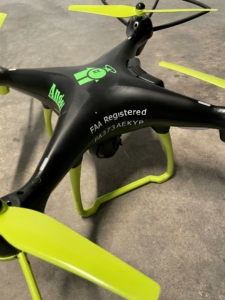
Angel Home Inspection’s properly registered and labeled drone
Drone Registration—The FAA requires small unmanned aircraft systems to be registered in certain circumstances. If the drone weighs more than 249 grams or is used commercially, you must register it with the FAA. Once the drone is registered, the drone must display the FAA registration number. There are commercially available stickers for placing the registration number on the drone. The registration process is simple. The drone is registered online, the owner pays the $5.00 fee, and a registration number is issued. https://www.faaregisterdrone.com/?gad=1&gclid=Cj0KCQjw756lBhDMARIsAEI0Aglg-2mvg1ab42DHSJWXw_qToi4SfCwfb-idl6S1BaJlU9AQ9WVxuxEaAlImEALw_wcB
Flight Restrictions–In addition to the remote pilot certificate and drone registration, the FAA rules regulate where a drone may fly and how high. The FAA also specifies the maximum altitude a drone may fly. The general rule is a small unmanned aircraft system’s altitude should not exceed 400 feet. Sometimes the altitude restriction varies. If the drone is flying over a building or physical feature, the drone may exceed 400 feet altitude provided it stays within a specific distance from the building or obstacle. Additionally, weather may also limit allowable flight altitude.
There are also different categories of FAA controlled airspace. For instance, in an area surrounding an airport drones may not be permitted to fly without a specific waiver from air traffic control. There are also “no fly” zones including Federal parks and certain Federal facilities. There is an app to help remote pilots to determine if the planned operation needs some type of authorization. https://www.faa.gov/uas/getting_started/b4ufly.

Sample aviation chart courtesy Internaichi
Legally the FAA has exclusive jurisdiction over all airspace in the United States but that has not stopped some local communities from imposing restrictions on the use of aerial drones. In fact, as of the date of this article, over 40 states have passed laws governing drones in some way, some of which impose criminal penalties for violations. Many in the drone community view local laws and ordinances as merely restrictions on “take-off and landing sites” since the FAA controls all airspace. However, a local police officer or sheriff probably has little to no knowledge of drone use regulations and will arrest a pilot for violating the local law. This means that the pilot in charge needs to do some research before every flying operation.
FAA regulations also cover flying over people or private property and flying at night. These regulations have both flight and equipment provisions the remote pilot must adhere to while flying. A discussion of the specifics of these rules is way beyond the scope of this article.
Conclusion:
Drone regulation is an ever changing and rapidly evolving activity. Although using drones during home inspections can be very beneficial, home inspectors must hold a Part 107 Remote Pilot Certificate, operate a properly registered drone, and obey all FAA flight regulations. If you are hiring an inspector who uses drones, you should ask about the inspector’s certification. If you are an inspector using drones, please make sure you are in compliance with all unmanned aircraft systems laws, rules, and regulations. Drones are not toys, please don’t ‘hire” that nephew with a drone to do any aerial photography or videography–unless he is properly certified by the FAA.
